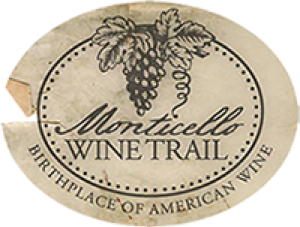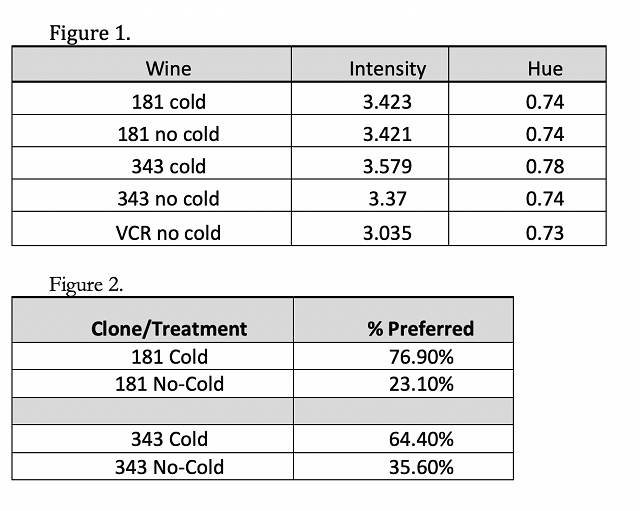Cold Soak vs. No Cold Soak with Merlot (2014)
Rachel Stinson Vrooman
Stinson Vineyards

Abstract
Purpose: Explore the effect of a cold soak protocol on color and levels of VA. Methods: Identically sourced Merlot Test 1: (clone 181) Test 2: (clone 343) was harvested, destemmed, and separated into two t-bins (0.77tons/bin). The trial t-bin was inoculated with 7g/hL D254, 96 hour cold soak, and an additional 7g/hL D254. The control t-bin was inoculated with 14g/hL D254 with no cold soak. Both were treated with Endozyme ICS10 Rouge (0.165mL/hL) and Fermaid O (20g/hL) after lag phase and ⅓ Brix depletion. Wines were treated identically and racked to neutral 2009 Taransaud (181) and neutral 2008 Seguin Moreau (343) barrels. Results: Spectroscopy showed no difference in color within clones between cold soak and non-cold soak groups (Figure 1). Results from the triangle tests for both the 181 and 343 clones showed a significant difference (p<0.05) between the groups (Figures 2& 3). Survey data indicated a strong preference for the cold soak group of the 181 clone, as well as a preference, though not as strong, for the cold soak group of the 343 clone (Figure 4). Discussion: The color analysis highlights the lack of a “traditional” cold soak outcome, but the triangle tests and preference data provide convincing evidence of alternative effects. Perhaps long-term color stability has been improved, but not yet tested. Conclusion: The cold soak had no measurable effect on color, however the taste difference was identifiable and preferable to the non-cold soak.
Presented January 28, 2015 at Trump Winery
Keywords: Cold Soak, Merlot, 343, 181, VA, D254
Cold Soak vs. No Cold Soak with Merlot
Introduction
This experiment was designed to compare the effect of a cold soak protocol on color intensity and the sensory attributes of Merlot. Two clonal varieties that are present at Stinson Vineyards (181 and 343) were studied independently. This provides additional information on cold soak effect and sensory attributes as well as eliminating bias in tasting based on clonal preferences.
Cold soak is a widely debated topic in wine making. Proponents claim that it brings better aroma, color extraction, mouthfeel, and tannin polymerization. Opponents, that it produces higher levels of VA and may not provide any additional benefits. Given these arguments and the additional time and energy invested into a cold soak, the decision remains a daunting one for many during harvest season.
Methods
Identically sourced Merlot Test 1: (clone 181) Test 2: (clone 343) was harvested on the same day, and moved into the winery overnight. The next day, each clone was separately destemmed, and put into two t-bins of equal weight (0.77tons/bin). The trial t-bin was then inoculated with 7g/hL D254 before a 96- hour cold soak (50F) was started. , At the same time, the control t-bin was inoculated with 14g/hL D254 and left at room temperature. After the 96-hour cold soak an additional 7g/hL D254 was added to the trial t-bin. Both were treated with Endozyme ICS10 Rouge (0.165mL/hL) and Fermaid O (20g/hL) after lag phase and ⅓ Brix depletion.
Wines were treated identically thru alcoholic fermentation, and pressed separately with identical programs. Wines were settled overnight and then racked to neutral 2009 Taransaud (181) and neutral 2008 Seguin Moreau (343) barrels. No ML bacteria was added.
Results
Spectroscopy showed no difference in color intensity or hue between cold soak and non-cold soak groups with clone 181(Figure 1). However, there was a 6% difference in both hue and intensity within the trial and control groups of the clone 343. The difference is small, but consistent between intensity and hue.
Triangle taste tests for both the 181 and 343 clones showed a significant difference (p<0.05) between the groups. Additionally, survey data indicated a strong preference for the cold soak group of the 181 clone, as well as a preference, though not as strong, for the cold soak group of the 343 clone (Figure 2).

Discussion
The color analysis highlights the lack of a “traditional” cold soak outcome, but the triangle tests and preference data provide convincing evidence of alternative positive effects. Perhaps long-term color stability has been improved, but not yet tested. Additional color analysis should be performed.
Lab analysis indicating VA levels was not performed, however, preference data would indicate that the trial fractions did not have a significantly higher VA as compared to the control. Additionally, pH values were not available, which provides a reasonable alternative for why the preference data would be skewed a certain way. More complete lab analysis would help to determine the value of cold soak in these experiments.
Conclusion
The cold soak resulted in a minimal effect on color intensity and hue, however sensory analysis would indicate that benefits of character in the finished wine. Absent lab analysis, it is hard to determine if the sensory benefit is due only to the cold soak, or if there are compounding variables.
References
Enology Notes #140 - Virginia Tech
www.apps.fst.vt.edu/extension/enology/EN/140.html
http://wineoscope.com/2015/01/08/the-value-of-cold-soaks-for-red-winemaking-the-value-of-cold-soak-research-for-winemakers/
https://psuwineandgrapes.wordpress.com/tag/cold-soak/
